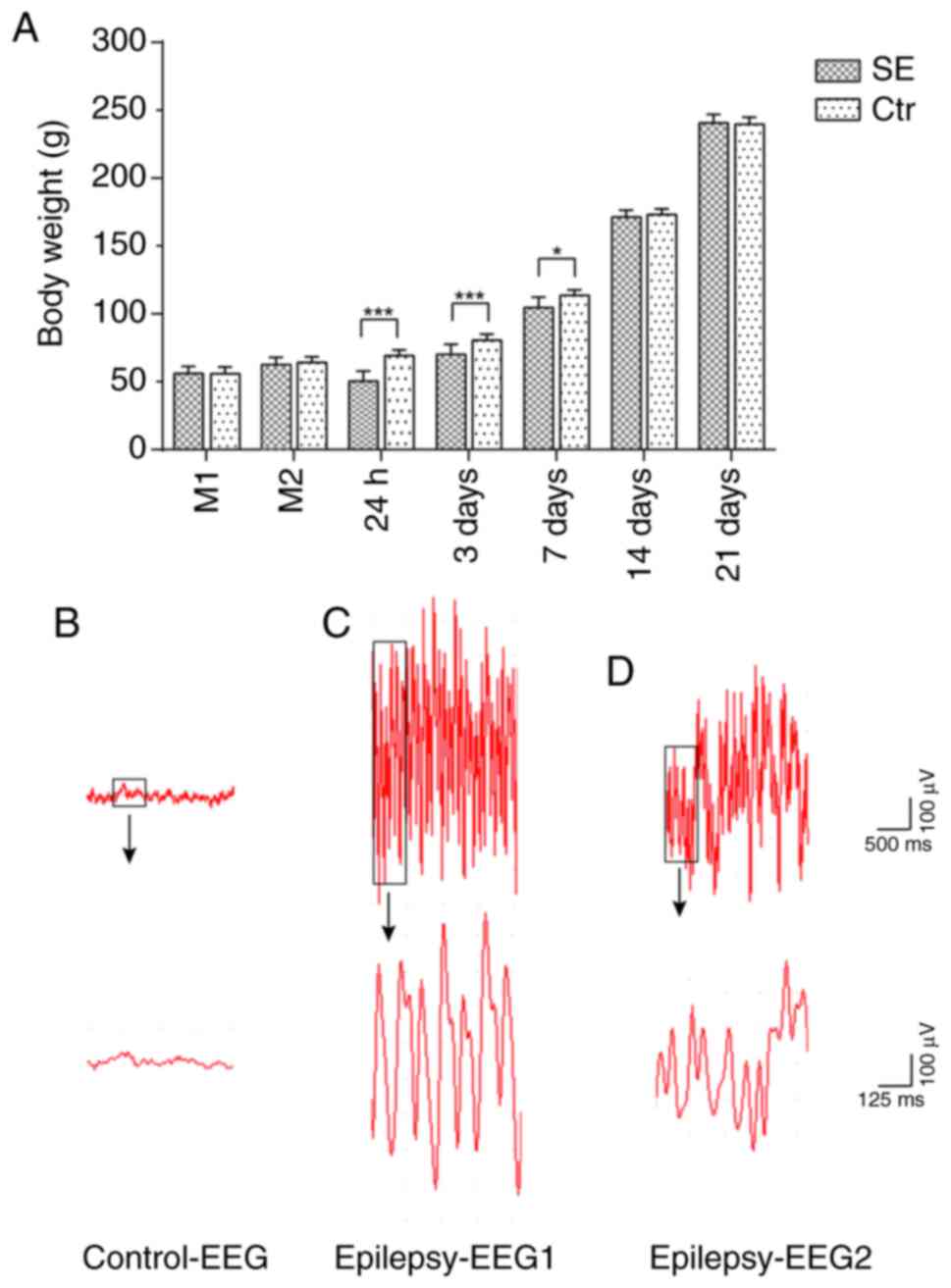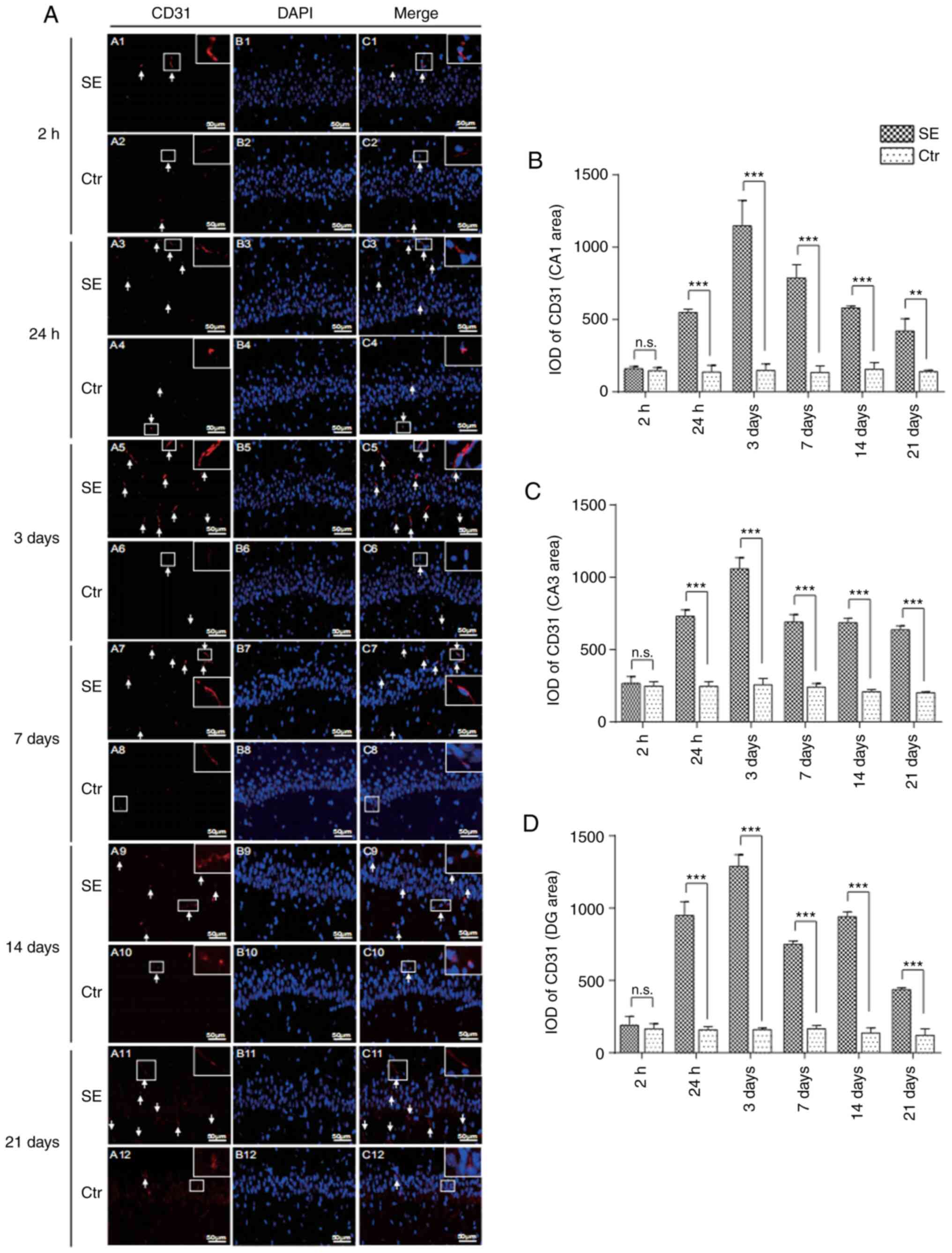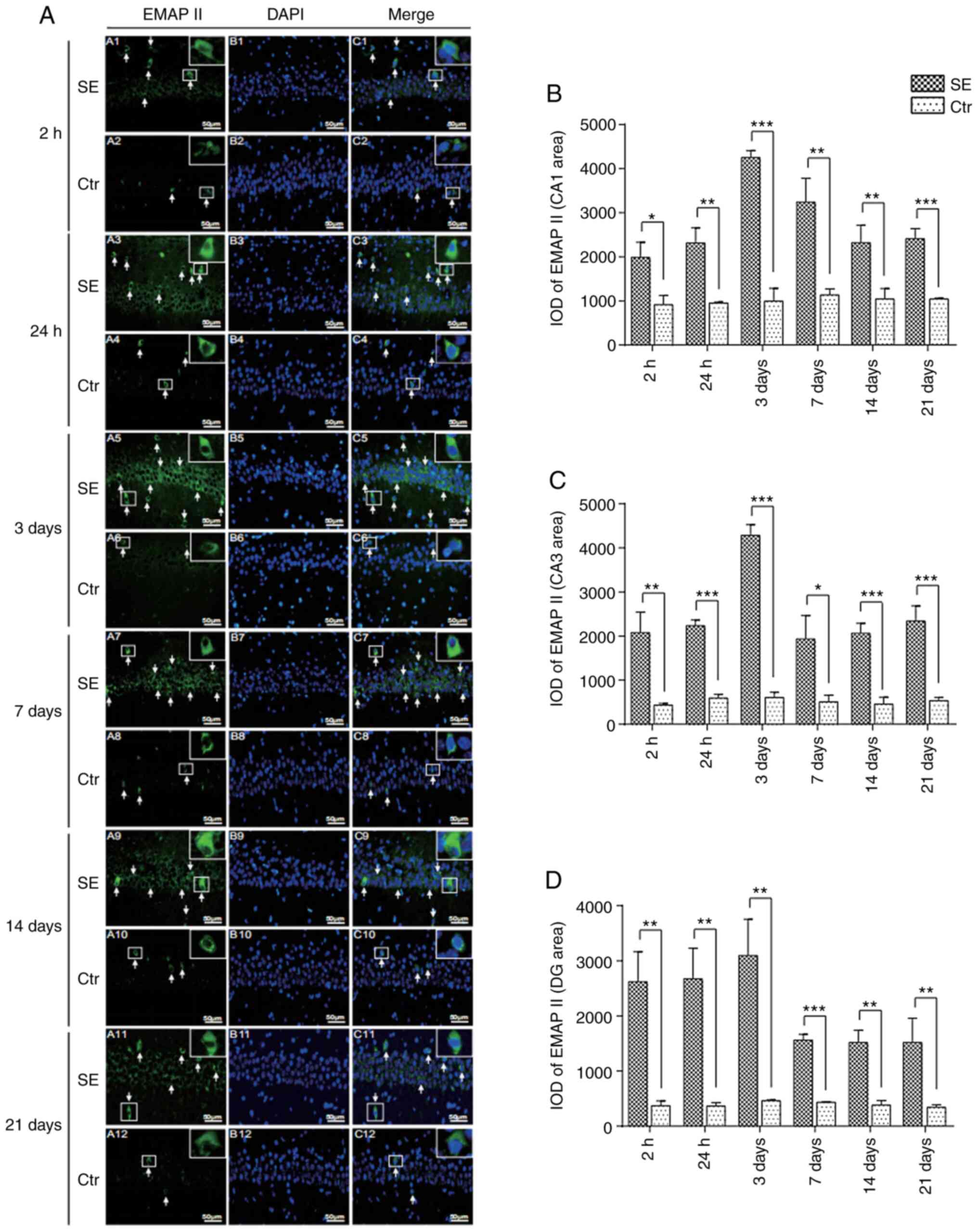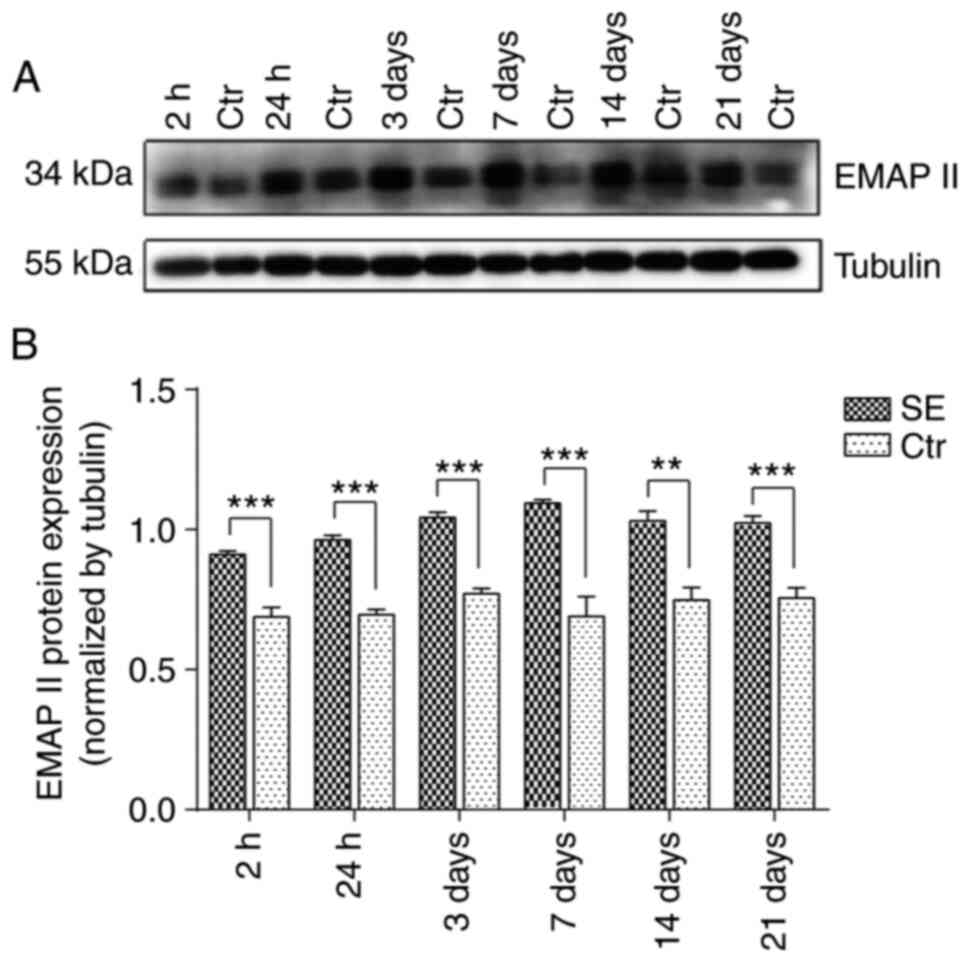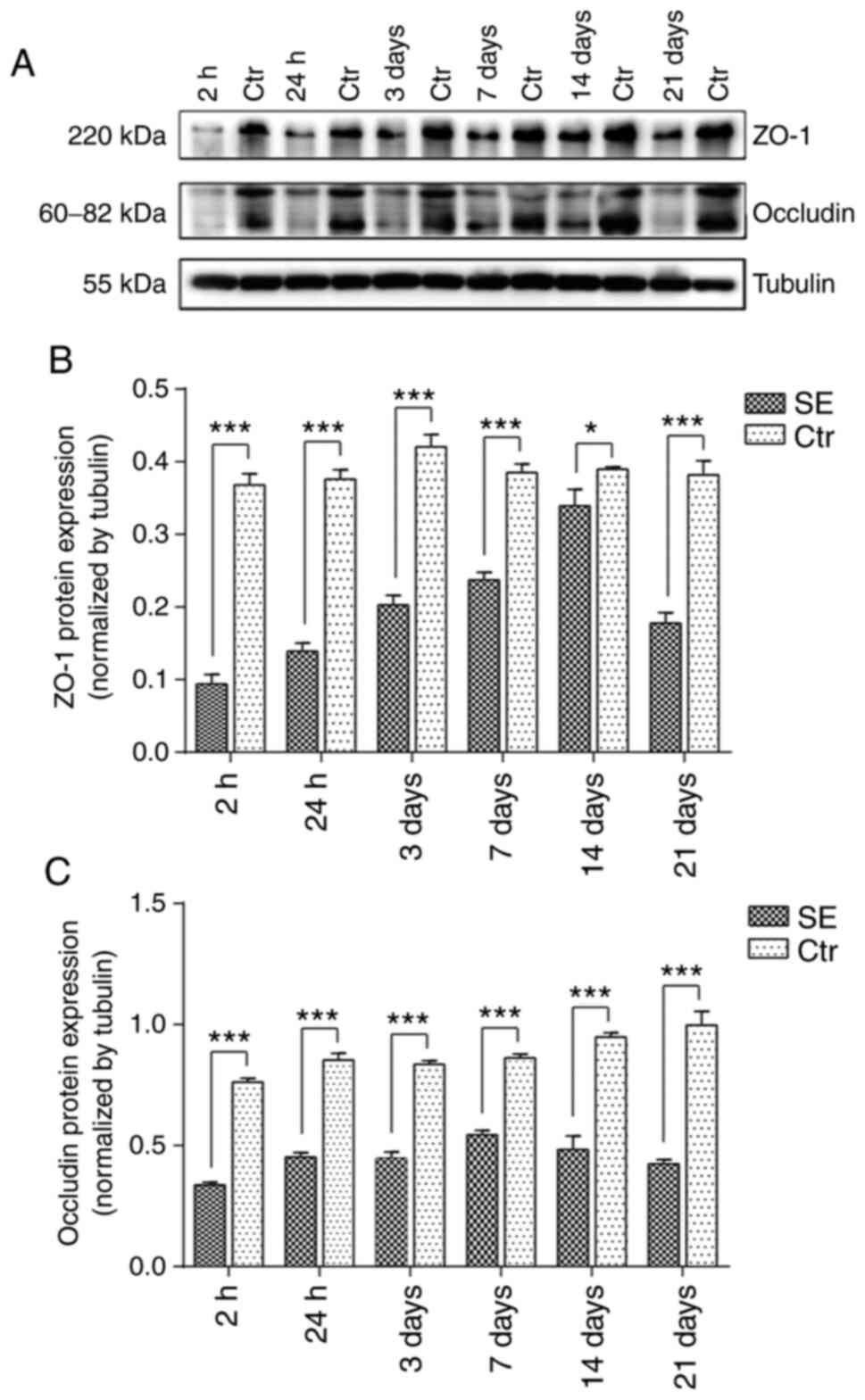|
1
|
Thurman DJ, Begley CE, Carpio A, Helmers
S, Hesdorffer DC, Mu J, Touré K, Parko KL and Newton CR: The
primary prevention of epilepsy: A report of the prevention task
force of the international league against epilepsy. Epilepsia.
59:905–914. 2018. View Article : Google Scholar : PubMed/NCBI
|
|
2
|
Fiest KM, Sauro KM, Wiebe S, Patten SB,
Kwon CS, Dykeman J, Pringsheim T, Lorenzetti DL and Jetté N:
Prevalence and incidence of epilepsy: A systematic review and
meta-analysis of international studies. Neurology. 88:296–303.
2017. View Article : Google Scholar :
|
|
3
|
Bertini G, Bramanti P, Constantin G,
Pellitteri M, Radu BM, Radu M and Fabene PF: New players in the
neurovascular unit: Insights from experimental and clinical
epilepsy. Neurochem Int. 63:652–659. 2013. View Article : Google Scholar : PubMed/NCBI
|
|
4
|
Takemiya T and Yamagata K: Intercellular
signaling pathway among Endothelia, astrocytes and neurons in
excitatory neuronal damage. Int J Mol Sci. 14:8345–8357. 2013.
View Article : Google Scholar : PubMed/NCBI
|
|
5
|
Mogylnytska LA: Endothelial
monocyte-activating polypeptide-II: Properties, functions, and
pathogenetic significance. Fiziol Zh. 61:102–111. 2015.In
Ukrainian. View Article : Google Scholar
|
|
6
|
Kao J, Houck K, Fan Y, Haehnel I, Libutti
SK, Kayton ML, Grikscheit T, Chabot J, Nowygrod R, Greenberg S, et
al: Characterization of a novel tumor-derived cytokine.
Endothelial-monocyte activating polypeptide II. J Biol Chem.
269:25106–25119. 1994.PubMed/NCBI
|
|
7
|
Yuan C, Yan L, Solanki P, Vatner SF,
Vatner DE and Schwarz MA: Blockade of EMAP II protects cardiac
function after chronic myocardial infarction by inducing
angiogenesis. J Mol Cell Cardiol. 79:224–231. 2015. View Article : Google Scholar :
|
|
8
|
Lal CV and Schwarz MA: Vascular mediators
in chronic lung disease of infancy: Role of endothelial monocyte
activating poly-peptide II (EMAP II). Birth Defects Res A Clin Mol
Teratol. 100:180–188. 2014. View Article : Google Scholar : PubMed/NCBI
|
|
9
|
Adly AAM, Ismail EA, Tawfik LM, Ebeid FSE
and Hassan AAS: Endothelial monocyte activating polypeptide II in
children and adolescents with type 1 diabetes mellitus: Relation to
micro-vascular complications. Cytokine. 76:156–162. 2015.
View Article : Google Scholar : PubMed/NCBI
|
|
10
|
Li Z, Liu XB, Liu YH, Xue YX, Wang P, Liu
LB, Liu J, Yao YL and Ma J: Roles of serine/threonine phosphatases
in low-dose endothelial monocyte-activating polypeptide-II-induced
opening of blood-tumor barrier. J Mol Neurosci. 57:11–20. 2015.
View Article : Google Scholar : PubMed/NCBI
|
|
11
|
Ma J, Meng F, Li S, Liu L, Zhao L, Liu Y,
Hu Y, Li Z, Yao Y, Xi Z, et al: Autophagy induction by endothelial
monocyte activating polypeptide II contributes to the inhibition of
malignant biological behaviors by the combination of EMAP II with
rapamycin in human glioblastoma. Front Mol Neurosci. 8:742015.
View Article : Google Scholar
|
|
12
|
Schikorski D, Cuvillier-Hot V,
Boidin-Wichlacz C, Slomianny C, Salzet M and Tasiemski A:
Deciphering the immune function and regulation by a TLR of the
cytokine EMAPII in the lesioned central nervous system using a
leech model. J Immunol. 183:7119–7128. 2009. View Article : Google Scholar : PubMed/NCBI
|
|
13
|
Zhu X, Liu Y, Yin Y, Shao A, Zhang B, Kim
S and Zhou J: MSC p43 required for axonal development in motor
neurons. Proc Natl Acad Sci USA. 106:15944–15949. 2009. View Article : Google Scholar : PubMed/NCBI
|
|
14
|
Armstrong L, Biancheri R, Shyr C, Rossi A,
Sinclair G, Ross CJ, Tarailo-Graovac M, Wasserman WW and van
Karnebeek CD: AIMP1 deficiency presents as a cortical
neurodegenerative disease with infantile onset. Neurogenetics.
5:157–159. 2014. View Article : Google Scholar
|
|
15
|
Knies UE, Behrensdorf HA, Mitchell CA,
Deutsch U, Risau W, Drexler HC and Clauss M: Regulation of
endothelial monocyte-activating polypeptide II release by
apoptosis. Proc Natl Acad Sci USA. 95:12322–12327. 1998. View Article : Google Scholar : PubMed/NCBI
|
|
16
|
Barnett G, Jakobsen AM, Tas M, Rice K,
Carmichael J and Murray JC: Prostate adenocarcinoma cells release
the novel proinflammatory polypeptide EMAP-II in response to
stress. Cancer Res. 60:2850–2857. 2000.PubMed/NCBI
|
|
17
|
Murray JC, Barnett G, Tas M, Jakobsen A,
Brown J, Powe D and Clelland C: Immunohistochemical analysis of
endothelial-monocyte-activating polypeptide-II expression in vivo.
Am J Pathol. 157:2045–2053. 2000. View Article : Google Scholar : PubMed/NCBI
|
|
18
|
Clauss M, Voswinckel R, Rajashekhar G,
Sigua NL, Fehrenbach H, Rush NI, Schweitzer KS, Yildirim AÖ,
Kamocki K, Fisher AJ, et al: Lung endothelial monocyte-activating
protein 2 is a mediator of cigarette smoke-induced emphysema in
mice. J Clin Invest. 121:2470–2479. 2011. View Article : Google Scholar : PubMed/NCBI
|
|
19
|
Rigau V, Morin M, Rousset MC, de Bock F,
Lebrun A, Coubes P, Picot MC, Baldy-Moulinier M, Bockaert J,
Crespel A, et al: Angiogenesis is associated with blood-brain
barrier permeability in temporal lobe epilepsy. Brain.
130:1942–1956. 2007. View Article : Google Scholar : PubMed/NCBI
|
|
20
|
Morin-Brureau M, Lebrun A, Rousset MC,
Fagni L, Bockaert J, de Bock F and Lerner-Natoli M: Epileptiform
activity induces vascular remodeling and zonula occludens 1
downregulation in organotypic hippocampal cultures: Role of VEGF
signaling pathways. J Neurosci. 31:10677–10688. 2011. View Article : Google Scholar : PubMed/NCBI
|
|
21
|
Ingram J, Zhang CF, Cressman JR, Hazra A,
Wei Y, Koo YE, Žiburkus J, Kopelman R, Xu J and Schiff SJ: Oxygen
and seizure dynamics: I. Experiments J Neurophysiol. 112:205–212.
2014. View Article : Google Scholar
|
|
22
|
Wu Q and Wang H: The spatiotemporal
expression changes of CB2R in the hippocampus of rats following
pilocarpine-induced status epilepticus. Epilepsy Res. 148:8–16.
2018. View Article : Google Scholar : PubMed/NCBI
|
|
23
|
Curia G, Longo D, Biagini G, Jones RS and
Avoli M: The pilocarpine model of temporal lobe epilepsy. J
Neurosci Methods. 172:143–157. 2008. View Article : Google Scholar : PubMed/NCBI
|
|
24
|
Glien M, Brandt C, Potschka H, Voigt H,
Ebert U and Löscher W: Repeated low-dose treatment of rats with
pilocarpine: Low mortality but high proportion of rats developing
epilepsy. Epilepsy Res. 46:111–119. 2001. View Article : Google Scholar : PubMed/NCBI
|
|
25
|
Racine RJ, Burnham WM and Gartner JG:
First trial motor seizures triggered by amygdaloid stimulation in
the rat. Electroencephalogr Clin Neurophysiol. 35:487–494. 1973.
View Article : Google Scholar : PubMed/NCBI
|
|
26
|
Paxinos G and Watson C: The Rat Brain in
Stereotaxic Coordinates - the New Coronal Set. 5th edition.
Academic Press; New York: 2005
|
|
27
|
Li J, Jiang G, Chen Y, Chen L, Li Z, Wang
Z and Wang X: Altered expression of hypoxia-Inducible factor-1α
participates in the epileptogenesis in animal models. Synapse.
68:402–409. 2014. View Article : Google Scholar : PubMed/NCBI
|
|
28
|
Ndode-Ekane XE, Hayward N, Gröhn O and
Pitkänen A: Vascular changes in epilepsy: Functional consequences
and association with network plasticity in pilocarpine-induced
experimental epilepsy. Neuroscience. 166:312–332. 2010. View Article : Google Scholar
|
|
29
|
Friedman A and Heinemann U: Role of
blood-brain barrier dysfunction in epileptogenesis. Jasper's Basic
Mechanisms of the Epilepsies [Internet]. 4th edition. Noebels JL,
Avoli M, Rogawski MA, Olsen RW and Delgado-Escueta AV: National
Center for Biotechnology Information (US); Bethesda, MD, USA: pp.
1–12. 2012
|
|
30
|
Castañeda-Cabral JL, Colunga-Durán A,
Ureña-Guerrero ME, Beas-Zárate C, Nuñez-Lumbreras MLA,
Orozco-Suárez S, Alonso-Vanegas M, Guevara-Guzmán R, Deli MA,
Valle-Dorado MG, et al: Expression of VEGF- and tight
junction-related proteins in the neocortical microvasculature of
patients with drug-resistant temporal lobe epilepsy. Microvasc Res.
132:1040592020. View Article : Google Scholar : PubMed/NCBI
|
|
31
|
Kim JY, Ko AR, Hyun HW and Kang TC: ETB
receptor-mediated MMP-9 activation induces vasogenic edema via ZO-1
protein degradation following status epilepticus. Neuroscience.
304:355–367. 2015. View Article : Google Scholar : PubMed/NCBI
|
|
32
|
Li Z, Liu YH, Xue YX, Xie H and Liu LB:
Role of ATP synthase alpha subunit in low-dose endothelial
monocyte-activating poly-peptide-II-induced opening of the
blood-tumor barrier. J Neurol Sci. 300:52–58. 2011. View Article : Google Scholar
|
|
33
|
Liao YL, Zhang ZY, Liu JW, Schluesener HJ,
Zhang ZR and Wu YZ: Lesional expression of EMAPII in
macro-phages/microglia following cerebral ischemia in rats. Int J
Neurosci. 121:58–64. 2011. View Article : Google Scholar
|
|
34
|
Brabeck C, Michetti F, Geloso MC, Corvino
V, Goezalan F, Meyermann R and Schluesener HJ: Expression of
EMAP-II by activated monocytes/microglial cells in different
regions of the rat hippocampus after trimethyltin-induced brain
damage. Exp Neuro. 177:241–246. 2002. View Article : Google Scholar
|
|
35
|
Li Z, Liu YH, Liu XB, Xue YX, Wang P and
Liu LB: Low-dose endothelial monocyte-activating polypeptide-II
increases permeability of blood-tumor barrier via a
PKC-ζ/PP2A-dependent signaling mechanism. Exp Cell Res.
331:257–266. 2015. View Article : Google Scholar : PubMed/NCBI
|
|
36
|
Li Z, Liu YH, Xue YX, Liu LB and Xie H:
Mechanisms for endothelial monocyte-activating
polypeptide-II-induced opening of the blood-tumor barrier. J Mol
Neurosci. 47:408–417. 2012. View Article : Google Scholar
|
|
37
|
Xie H, Xue YX, Liu LB, Liu YH and Wang P:
Role of RhoA/ROCK signaling in endothelial-monocyte-activating
polypeptide II opening of the blood-tumor barrier: Role of
RhoA/ROCK signaling in EMAP II opening of the BTB. J Mol Neurosci.
46:666–676. 2012. View Article : Google Scholar
|
|
38
|
Park SG, Kang YS, Ahn YH, Lee SH, Kim KR,
Kim KW, Koh GY, Ko YG and Kim S: Dose-dependent biphasic activity
of tRNA synthetase-associating factor, p43, in angiogenesis. J Biol
Chem. 277:45243–45248. 2002. View Article : Google Scholar : PubMed/NCBI
|
|
39
|
Schwarz RE, Awasthi N, Konduri S, Caldwell
L, Cafasso D and Schwarz MA: Antitumor effects of EMAP II against
pancreatic cancer through inhibition of fibronectin-dependent
proliferation. Cancer Biol Ther. 9:632–639. 2010. View Article : Google Scholar : PubMed/NCBI
|
|
40
|
Awasthi N, Schwarz MA, Verma V, Cappiello
C and Schwarz RE: Endothelial monocyte activating polypeptide II
interferes with VEGF-induced proangiogenic signaling. Lab Invest.
89:38–46. 2009. View Article : Google Scholar
|















